Newsletter 148, December 2023

In this issue
Notices
New contract for NZFFA
Te Uru Rakau – NZ Forest Service has asked us to run a series of 20 field days around the country, demonstrating the success of alternative exotic species. These build on the “Opportunity from trees” workshops we delivered earlier this year where people asked for more information about choosing and growing alternative species. The field days will allow branch members and the TUR-NZFS Forest Advisory Service to follow up with those who attended the workshops, and provide more detailed information on tree selection, management, performance and financial returns. The contract will cover all costs, so there is no charge for participants.
The idea is for each field day to run for around 3 hours and:
- focus on exotic tree species that have proven successful in that region (maybe 2 or 3 in particular)
- include a property tour (minimum two hours onsite)
- provide a description of where to plant each species and why
- explain why the trees were chosen and how they were planted
- explain their survival and performance
- outline the environmental benefits the trees provide
- explain the costs and expected returns on investment
- Identify species requirements in terms of:
- Location
- Temperature
- Soils
- Shelter
- Moisture
- Establishment and performance
- Weed and pest control
- Management
What we envisage is say a half-hour introduction in the woolshed with tea or coffee where the landowner explains the nature of the farm, why those species were chosen, what problems arose, and how successful they’ve been. Then a tour of the property showing off the trees with more information and questions and answers. Finally, another half hour general session back in the woolshed talking about other alternative species, which ones are suitable for the region and how they perform. Members would be welcome and could talk about their own experiences. The format may be something like the field trips at an annual conference, except we’re not providing buses.
If you have a property that could be show-cased in this way, or know of one or two in your branch, please send me an email at treasurer@nzffa.org.nz so that we can start working out a schedule. Head office will develop a template for the field days, help arrange publicity, provide handouts, manage registrations, meet all of the costs and generally work with each branch to make each event a success.
We need to run 20 field days, regionally spread, and we hope branches can use them to attract new members as well as make a little money. And maybe have some fun.
Please get in touch before Christmas if you think there is a good property in your area, and a group willing to help. Thanks.
Howard Moore
Subscriptions – and Christmas hours
If you are having trouble renewing your NZFFA subscription on-line, blame me. The first step in my instructions should have been to ask you to log on, then go to this link https://www.nzffa.org.nz/subscriptions/renew. It allows you to check what you entered last year, and change it if necessary. Then you can decide whether to pay by credit card or internet banking.
If you’d rather pay manually and want Liz to help, either with advice or a printed invoice, by all means give her a call but do it in the morning, as she only works part time. I’ve asked her to be especially nice to old men offering her money.
Liz will also take a Christmas break, so don’t expect her to answer after Friday 22 December and before Tuesday 9 January. It it’s urgent and you are extraordinarily optimistic, try my number instead: 04 9388 060. Who knows?
Howard Moore
Stihl Farm Forester of the Year
Our long-running association with Husqvarna has finally come to an end, with some regret on both sides. However, Stihl https://www.stihlshop.co.nz/ has stepped up, offering sponsorship for our 2024 Conference and for the North and South Island Farm Forester of the Year Awards. Expect to see more of their battery and petrol-driven equipment, and give them your support if you can. Orange is the new black.
Changes to the rules
We have to make some changes to the NZFFA Constitution (our Rules) now that the Government has amended the Incorporated Societies Act. The requirements don’t seem onerous, and it’s time we looked at our Rules in case there are any other sections that are confusing or out of date. Our plan is to lean over the shoulder of some other organisations to see what words they have chosen for key clauses, like dispute procedures. If any member is involved in such a review for anyone else (e.g. Rotary, or the Karori Arts and Crafts Society Inc) please get in touch with Treasurer@nzffa.org.nz so that we can form a small team to draft our own changes. Hamish and I would like to run them past the Council before the conference in April.
Howard Moore
Southern Field Days, Gore, February 14-16
The NZFFA has booked a stand at the Southern Field Days in Waimumu, Gore, for February 14-16 next year. We’re going to use all of the display material we had for Mystery Creek, and do our best to make just as big an impact. Some of the members who ran the stand at Mystery Creek will be descending on Gore in February with all the gear. If you live nearby and want to be a part of it, or to offer beds, food or drink please email Vaughan Kearns on ruapehusawmills@xtra.co.nz. Head Office will pay all reasonable bills and it helps to have plenty of supporters. It should be lively and fun.
Clearfell and Kiwi – a good news story
Justin Anderson and his logging crew, JPA Logging, have recently completed a delicate logging job. Contracting to John Turkington, they have just finished harvesting a 50-hectare pine block on Haupouri Station, part of the Cape Sanctuary, which is the home to a large population of Eastern brown kiwi. Tricky? Yes. But it helped that the Kiwi were all caught and fitted with transmitters before logging started, which meant they could be found each day. Then the crew could either work where the Kiwi weren’t, or call on the DOC handler to move the odd one out of harm’s way. I’m sure the Kiwi were surprised by the changes to their habitat, but hey, none got squashed. The full story is here.
Natural regeneration post-pine harvest
I'm leading a research project at Manaaki Whenua - Landcare Research looking at post-pine harvest natural regeneration. I'm looking for some field sites where we could put in some plots to measure the vegetation diversity post-harvest. Any help would be appreciated.
Suzanne Lambie
lambies@landcareresearch.co.nz
Uruguay field trip – plantation forestry a high performer
Apparently forestry development in Uruguay has been outstanding, including small scale forestry. Over the last 30 years, total eucalyptus and pine plantation area has increased from 50,000 ha to over a million ha. At the same time large internationally competitive wood processing plants have been established. One in particular concentrates on short fibre market pulp from Eucalyptus plantations. The Government welcomes foreign finance, and there have been promising returns on investment (https://uruguay.uy/en/forestry) .
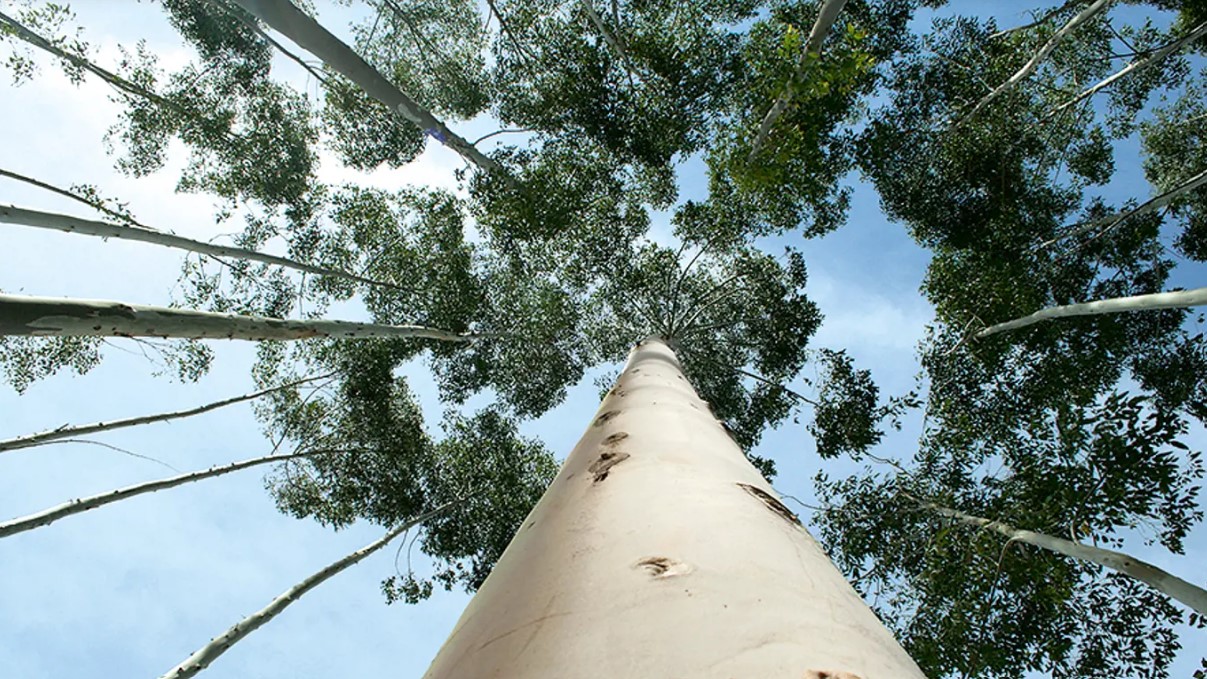
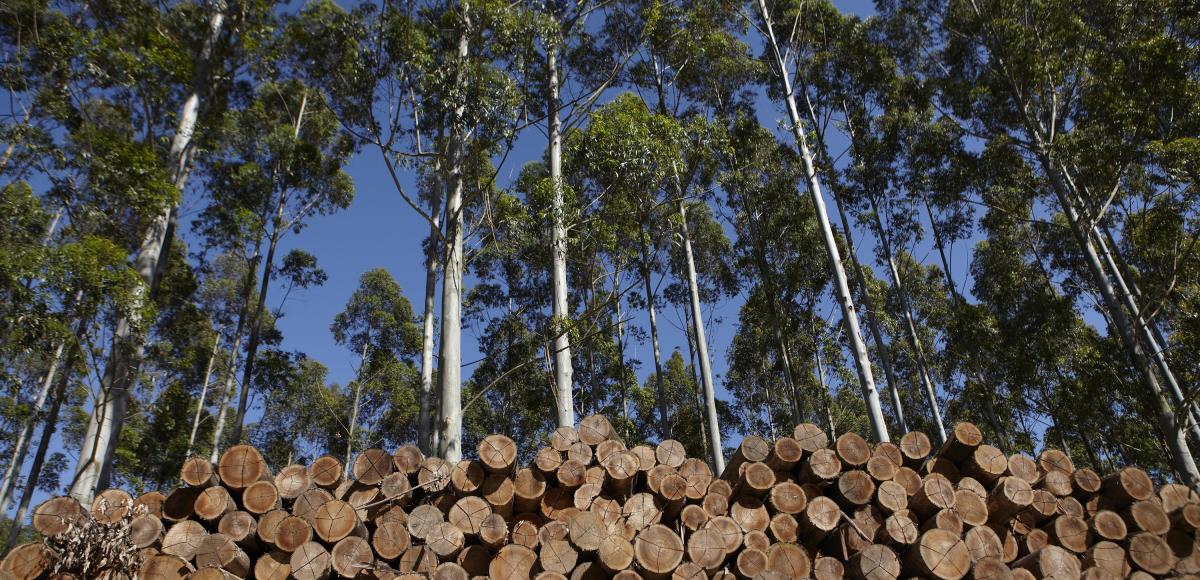 Eucalyptus logs grown for high quality short fibre pulp – Uruguay Government website
Eucalyptus logs grown for high quality short fibre pulp – Uruguay Government website
Bill Triplow, through his successful investment in one forest there, has developed a range of useful contacts in Uruguay and is offering to escort a forestry study trip to Uruguay (that may well also be tax deductible for many participants) in March-April 2025. He is working on an itinerary and budget. Meanwhile, if you are interested in being part of this group contact Bill (wrtforestry@gmail.com). I am attracted to joining the group myself.
Hamish Levack
Events
For more information on these events, they are posted on the NZFFA website »
Branch secretaries, please make sure you notify head office of any branch or action group events.
- Wellington Branch AGM Sunday 11 February 2024 - Save the date Dave Gratton's forest-farm in Upper Hutt. Details to be provided closer to the date.
- Bay of Plenty Field Day - Bellamy Farm Saturday 17 February 2024 - SAVE THE DATE Bay of Plenty Branch Field Day & AGM Bellamy Farm. Rita & Paul Bellamy have been planting for years and have various blocks of…
Tree Grower articles
- Planting native trees. Feeding the soul not the bank account (Access: NZFFA membership)
Julian Bateson, November 2023
There are many experts who know lots about New Zealand native trees, how to plant them and ensure they survive grow well. I am not one of these experts. However,… - Airships – an alternative transport for forest harvesting? (Access: NZFFA membership)
Lorna Zach, November 2023
We have all heard of airships, lighter-than-air craft which can navigate under their own power and these days may be operated by remote control. In calm conditions they can take-off… - An update on harvested wood products - A simple idea made complex (Access: NZFFA membership)
Howard Moore, November 2023
Some things appear to have a beautiful simplicity. A friendship, a seashell, a single malt. Of course, if you choose to go nit-picking you can discover details in each which… - A guide to Japanese Cedar (Access: NZFFA membership)
NZFFA, November 2023
This is another of the species guides prepared to help new growers understand which ones would probably so well on which sites. Afuller version of this guide for cedar is… - Applications for money from the Forest Growers Levy and Te Uru Rakau for projects in 2024 (Access: unrestricted)
Julian Bateson, November 2023
It seems only a short time ago that I last wrote an article about grant projects for small-scale forestry. If you check the May Tree Grower, you will see it… - Transforming forest management The precision silviculture programme (Access: unrestricted)
Claire Stewart, November 2023
The precision silviculture programme is the most recent addition to the Forest Growers Research programme, complementing the five other government and industry partnerships already under way. The programme is just entering… - NZFFA Submissions on government consultation (Access: NZFFA membership)
Julian Bateson, November 2023
Over the past few years various government departments have put forward proposals which directly or indirectly affect forestry. Part of this process involves requests for submissions about these proposals from… - The Emissions Trading Scheme - Where to next? (Access: NZFFA membership)
Ollie and Mathilde Batelier-Belton, November 2023
This article is the seventh of a series about the New Zealand Emissions Trading Scheme. The year 2023 has proved to be a year of remarkable disruption within New Zealand’s… - Methane, cows and citizenship (Access: NZFFA membership)
Howard Moore, November 2023
When you think about it, there is a really simple solution to New Zealand’s methane problem – shoot lots of cows. Naturally this idea upsets farmers, especially dairy farmers, so… - Resilient landscapes - The Hawke's Bay conference (Access: unrestricted)
Hawke's Bay Branch, November 2023
From 9-13 April 2023 Napier War Memorial Conference Centre If there is ever a year which called on resilience, it is this one. It is only fitting that the theme… - More activity for the NZFFA branches and perhaps more members (Access: NZFFA membership)
Julian Bateson, November 2023
Over the past few months, NZFFA members have submitted a number of grant applications to the Forest Growers Levy Board and Te Uru Rakau – NZ Forest Service. A summary… - President's Comment (Access: unrestricted)
Neil Cullen , November 2023
The election has happened but it is going to take some weeks to find out the final form of the new government and who our new Minister of Forests will be.…
Headlines
- Planting trees on pasture can have a positive impact on soil health December, 2023. Rather than damaging soil in New Zealand, planting trees on pasture restores soil to be similar to its original condition. A recent news story highlighting changes in soils from converting…
- Forest plantation soils have benefits too December, 2023. The Forest Owners Association (FOA) says the fact that soils under plantation forests are similar to soils under native trees, does not make them damaged, as a recent Newshub report has claimed.…
President's Comment
The Forest and Wood Processing Sector Forum met on Monday 4th December and were pleased to have a brief introductory meeting with the new Forestry Minister, Todd McLay. The Minister stated that the National Party Policy paper that was released before the election is the starting point for his work as Minister. His initial objective is to create certainty as to the role of forestry both for the products it produces and as a carbon sequesterer. He feels a lack of clear signals has caused a lot of the issues and debates around land use. As Minister of both Forestry and Agriculture he believes there is plenty of land for both activities and agrees that land use conflicts are largely unproductive and can be avoided with clear signals and policy. The new Government will take some time to work through getting the settings right around the ETS and desired new planting numbers and develop a long term view for forestry. There was no mention of the increased costs now incurred by ETS users.
The group took the opportunity to express their support for the objectives of the Industry Transformation Plan and the desire to keep that work progressing in some form. The issues, we felt that the ITP is addressing such as price volatility, need for more diverse markets, and more resilient forests needed also to be at the front of Minister McLay’s mind. He emphasised that the Government would be meeting the countries obligations on nett emission reductions and as Trade Minister he would be working hard to reduce barriers for our timber and log exports. He is planning to visit India before Christmas and in future trips is keen to include representatives from the forest and wood sector. A useful first meeting but we wait for the detail.
As the year draws to a close it is my pleasure to wish everyone seasons greetings and to thank the many members for their selfless work that keeps NZFFA running. I came across a dictum recently from Robert Louis Stephenson that seems to be the ethos of many farm foresters, Judge not your day by the harvest you reap but by the seeds that you plant.
Neil Cullen
Billboards
These were installed in August, back-to-back, on Rob Hewett’s farm at Round Hill, 5 km east of Waitahuna beside SH8 and the Clutha Gold cycleway. We owe big thanks to Rob who contributed timber for the framework plus the use of his land, and also helped David Vollweiller and Neil Cullen with construction:
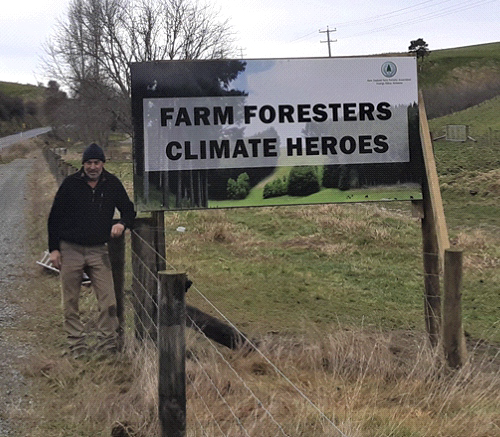
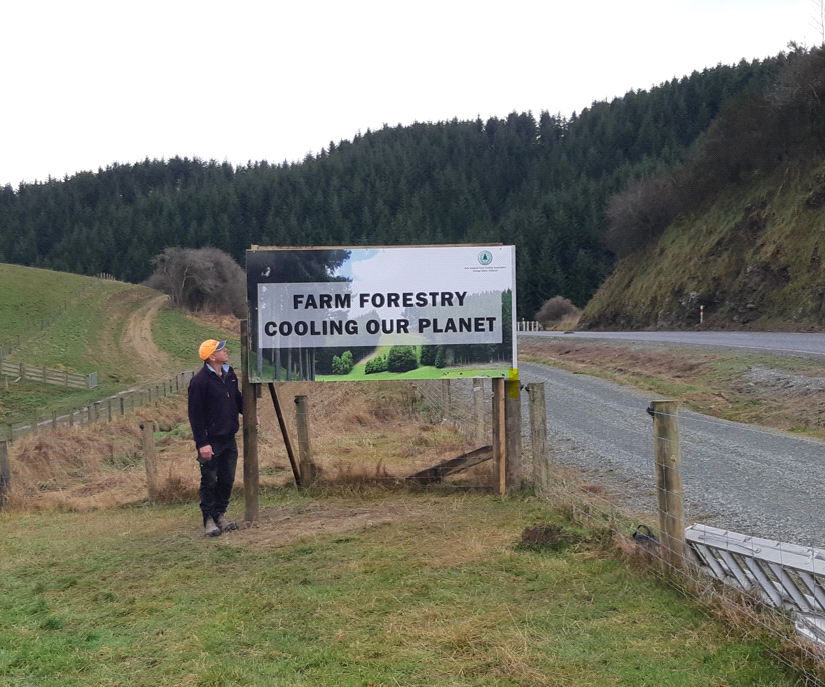
Pongakawa field day a poster child?
The Bay of Plenty Branch coordinated a successful field day on the property of Ann and Will Nettleingham at Pongakawa on 2nd November. The day was themed around “Towards freshwater improvement” and has been reported in the Farmers Weekly and in the NZ Herald. Amazingly, 85 people attended and while the event has also been reported in the recent meetings of the NZFFA Executive and Council, it was thought useful to nationally report on why there was so much interest and what have we learned from it. For the full story, check the Herald link. To keep it brief here I will simply provide bullet points.
- The driver for the day’s theme was the government’s National Policy Statement for Fresh Water that requires Regional Councils to develop policies for the management of freshwater by 2025.
- Initiatives are being taken in most regions to form Catchment Groups which will help facilitate the consultation on policy development. The relevant catchment group for our field day was the Wai Kokopu Inc Society. This has raised 4-year funding totalling $7.5m from MPI, MFE, Bay Trust, and TECT, which has so far been used for the development of climate resilient solutions, carbon farming, and lower footprint farming systems.
- The Regional Council reported that about 70% of the nutrients etc that entered the water ways in this catchment was from overland flow from heavy rainfall.
- From the outset the field day was going to be a collaborative effort involving many local stakeholders - Wai Kokopu, BOP Regional Council, Ballance Agi-nutrients, Federated Farmers, and BOP FFA among others.
- The farmers (mostly dairy) requested a short field day that started at 10 am and finished by 2 pm. This included a cooked lunch that was sponsored by Balance and BOP FFA.
- Commercial tree planting on the farm was planned and mapped by a forestry consultant in consultation with landowners. Suitable areas were identified as anything reasonably steep (>20 degrees) and compliant with the ETS. Areas that were suitable for a possible timber harvest were planted in Radiata pine, steeper blocks with less access were planted in Coast Redwoods. All blocks are intended to be registered in the ETS.
- Native planting was predominantly in the retired riparian zones of the Pongakawa river but also extended into the steeper areas.
- Re-fencing was required (4 wire electric) in some areas to achieve clear valley bottoms or plateaus. Boundaries were curved where possible and planting was along the contour.
- 20% of the farm was now in trees and this seemed to be acceptable.
- The transition of land use was noted as a long-term journey and the benefits take time to accrue. Financial establishments (Banks) should be part of the discussion as they can be quasi equity holders.
The major lessons learnt were: collaboration with other stakeholders is vital to get ownership of the problems and build trust, farm forestry expertise with commercial forests is valued, consultation on the new water quality regulations is an opportunity for NZFFA to engage with catchment groups, raise our profile and attract members.
Graham West – BOP Branch
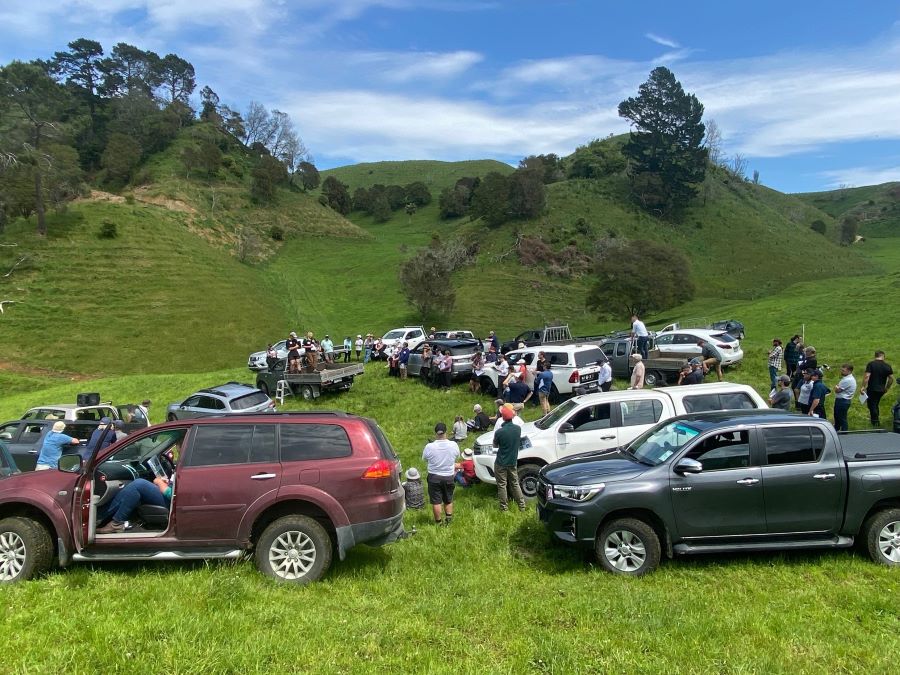
Photo: Alison Dewes (Wai Kokopu technical advisor).
Small-scale low impact harvest in Northland
The Northland branch of NZFFA held a well-attended field day on 20 Sep 2023, to demonstrate how a small block harvest can be managed profitably and with low environmental impact.
Pam and Peter Kelly recently sold their livestock farm about 20km north of Dargaville, but they kept the cutting rights to a 14 ha block of 30 year-old radiata that they had planted. They had also planted other younger woodlots but these were sold on as part of the farm. They engaged Peter Davies-Colley to act as harvest manager, and it was mainly he who talked us through the harvesting process.
The woodlot being harvested is nearly 2km from the road, and this distance made the creation of a normal forestry road for logging trucks, at a cost of about $100,000 per km, take up a large percentage of the profit from the trees. However Peter D-C and his team have a different approach.
Only a short length of forestry road was built (about 300 metres), so the logging trucks can get from the road to a flat log-collection and loading area. The logs are brought from the harvest site to the logging trucks by a fleet of specially-modified small 4WD trucks (mini loggers), that are light enough to be able to use a temporary dirt track created by simply scraping the topsoil away and pushing it to the side. At the end of the harvest, the topsoil will be scraped back and grassed over again. (This method is certainly helped by the fact that this is sand country).
There are 4 of these mini loggers, and 2 drivers, and the drivers are constantly on the go, rotating between the trucks as they are loaded at the harvest site and unloaded onto the big lorries at the collection point.
As an additional cost saving, Peter D-C pointed out that while most forestry trucks and other equipment use 25-45 litres of diesel per hour, the mini loggers use only 16-20 litres per day.
The farm was set up by the Kellys to use very intensive grazing cells, which involves lots of fencing and water reticulation pipes to keep up the pasture (and lots of fertilizer). The new owner had been concerned that he would not be able to use the grazing cells next to the track due to damage to the pipes and disturbance of the cattle, but Peter’s team has been very careful with the pipes, and because the mini loggers are not very noisy the farming activities have been able to continue through the harvest.
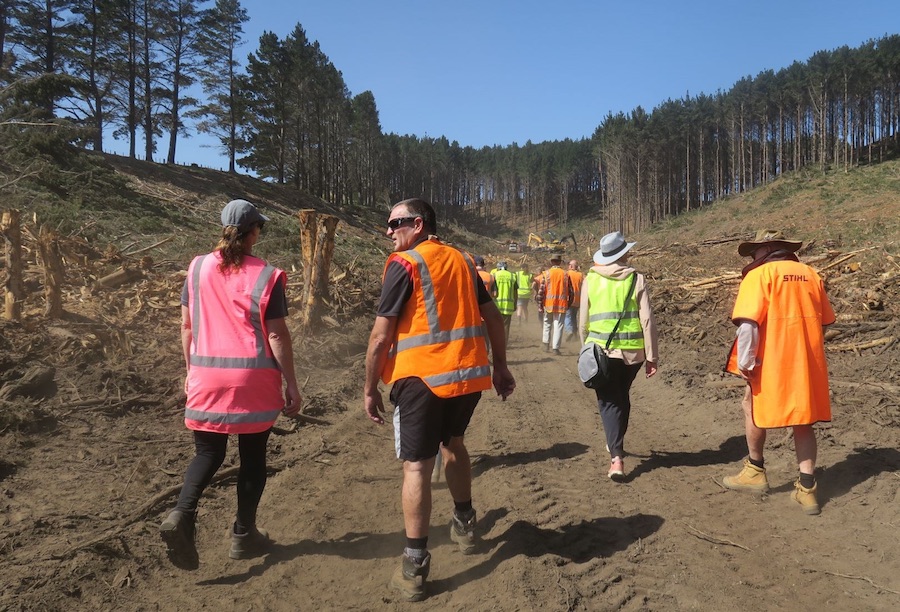
We went to watch the harvesting in progress also. It is all done by machinery – no manual felling. But again the machinery is selected for being lightweight. The feller-buncher is only 32 tonnes, and the processor was a similar weight. A more usual machinery size would be 45-50 tonnes. This means less damage to the soil, and the machines can move about the site more easily. Additionally, the logs are moved between feller-buncher, processor and the mini loggers by grapplers, they are not “shovelled” or dragged across the soil.
Peter D-C was pleased with the processor although he winced a bit at the cost - brand-new at just over $800,000, it had only been in action a week. It strips the branches, and cuts the trees into logs (5.2m or 4m in this case, as the Kellys pruning lift wasn’t quite enough to get 6m logs). It also automatically marks the butt end of each log with paint – green for the Kellys. I had never known why the logs are marked like this, but Peter explained it was because the JAS log grading is always done based on the small-end diameter, so it is necessary to know quickly which end is which and it is always the butt end that is marked.
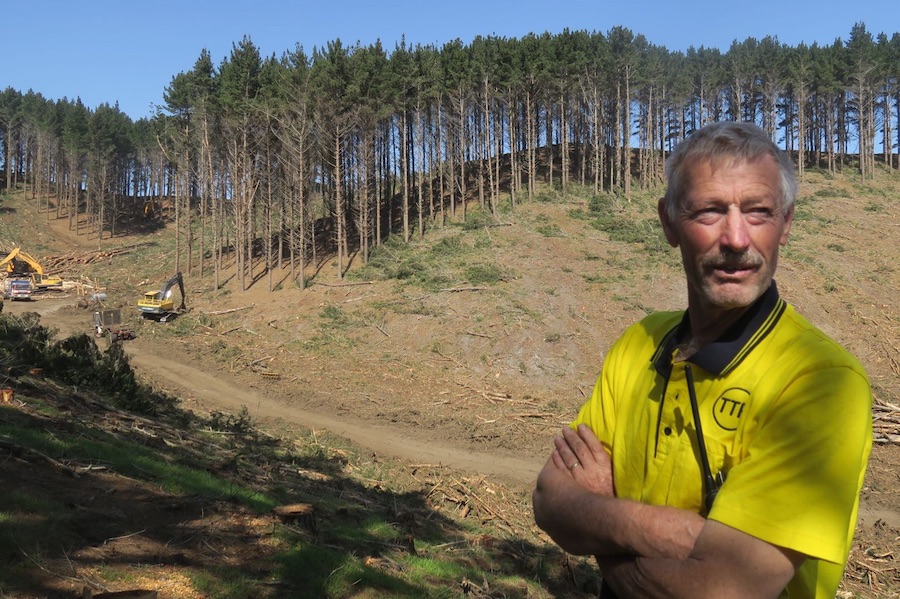
Peter Davies-Colley talking to us at the harvest site
The harvest site is a small dry-bottomed valley, and at the time of our visit they had been working on it for 5 weeks and had 3 weeks to go. Peter D-C said ideally he likes to move steadily through a block, but owing to weather some of the slopes had been a bit too wet to put even this lighter machinery on, so the site had a slightly patchwork effect. Also he normally likes to clear up as they go, but when booking the logging trucks for the harvest he was told they would only be available for a short period and so he has prioritized actual harvesting so they can get the logs away, and they will clear up afterwards. There will be very little left on site, just the pine needles, which is where he said most of the nutrient of a tree is stored, with the logs themselves being mostly carbon and water. So in this respect, forestry is more environmentally-friendly than intensive livestock farming where nutrient is brought in and all the output goes off-site.
There are 7 in the Davies-Colley team (including Peter), and all are very experienced and qualified. Several of them are grandfathers. The working day is long, 6am to 5pm, but there are 3 compulsory breaks in the day, and everyone must leave the harvest site for these breaks. There was lots of laughter coming from the tea caravan when we arrived – obviously a team that works well together.
The Kellys and Peter D-C are hoping to get 8000 tonnes of logs from this 14 ha block, and hoping to net $250,000. The logs were offered to local mills first but they couldn’t take the whole harvest so most is going through the port. Smaller scrubby logs are going to Portland Cement for biofuel. Although the trees are 30 years old, they are not actually huge trees, as this is dry and infertile country. There is no understorey at all under the pines, and Peter Kelly said that even gorse won’t grow on this land. The original native forest here was 2m high scrub.
The new owner of the block is “not interested in trees” – so it is likely this block will just be re-grassed after harvest and used for stock, rather than replanted. But there are younger radiata blocks sold with the farm, that will be ready for harvest in a few years, so hopefully this landowner will get a chance to consider his options.
Peter D-C is proud of the harvesting operation he runs. He said not many people ever get to see a small-scale harvest, as they are normally well away from public roads. What the public mostly sees is the large-scale industrial harvests and their aftermath, and this is a real problem for forestry’s social licence to operate. However he did mention that the general manager of Panpac in the Hawkes Bay, with huge remote forests, is keen to come and see his setup! Peter is also involved in the Northland Wood Council, so maybe his ideas and methods will be more widely adopted in future?
Peter also spoke briefly about managing a harvest. There are 3 parties to the operation – the forest owner, the harvest manager, and the contractors. For the Kellys harvest, Peter D-C is both the harvest manager and a contractor. There are some bad stories about harvesting experiences and returns, so the contract is important. He said owners need to let managers know they are being monitored, and no contract should say the owners are liable if the stumpage is negative.
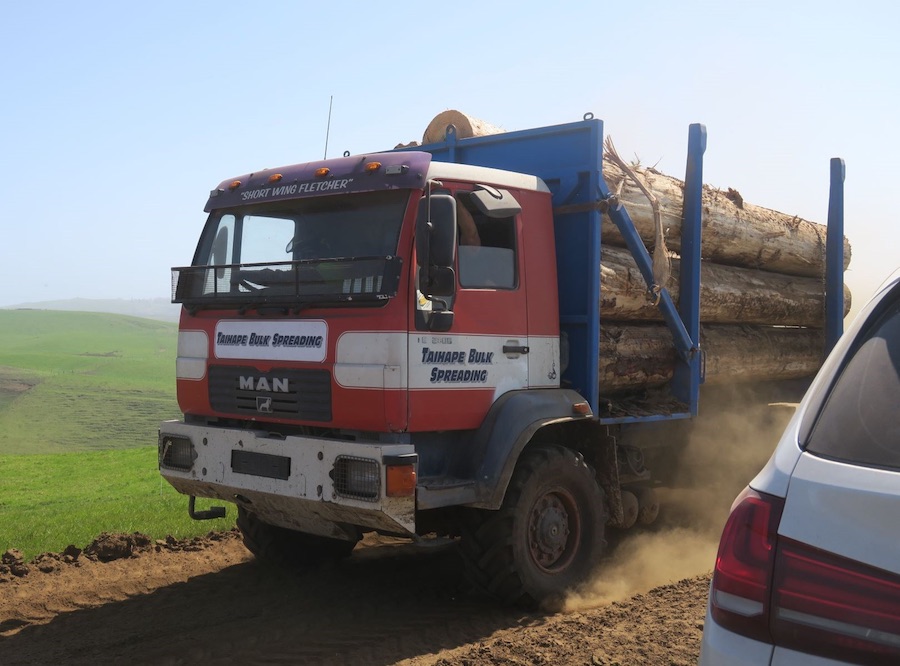
The converted 4WD mini logger trucks using the lightweight dirt road, and showing the load they can carry.
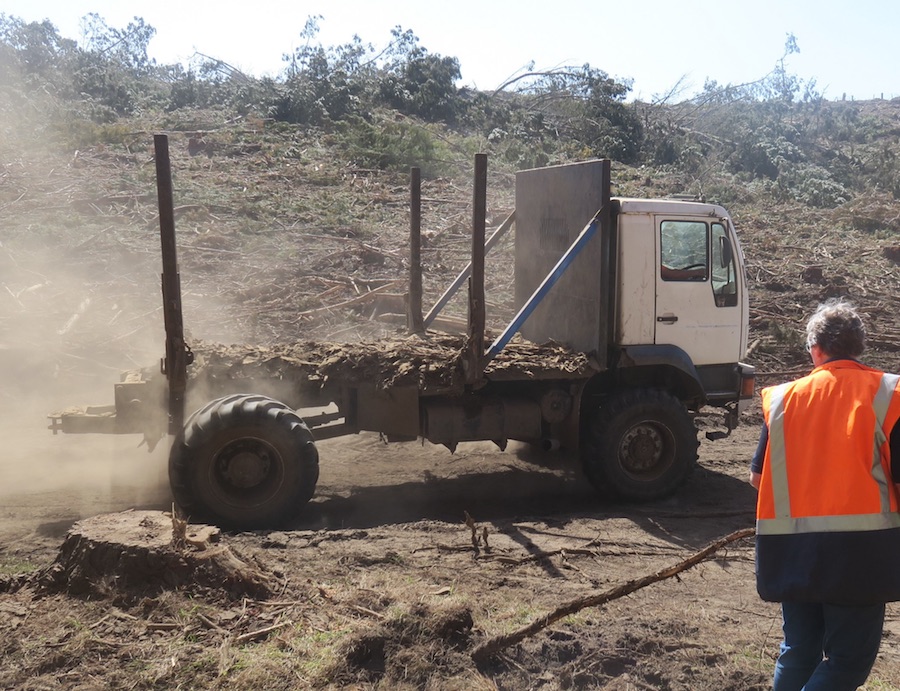
An empty mini logger. Farm Foresters in high viz.
This was a most enjoyable and informative day – thanks very much to the Northland branch team that put it together, including the Kellys, and Peter and Nancy Coates and Simon Webb from the committee.
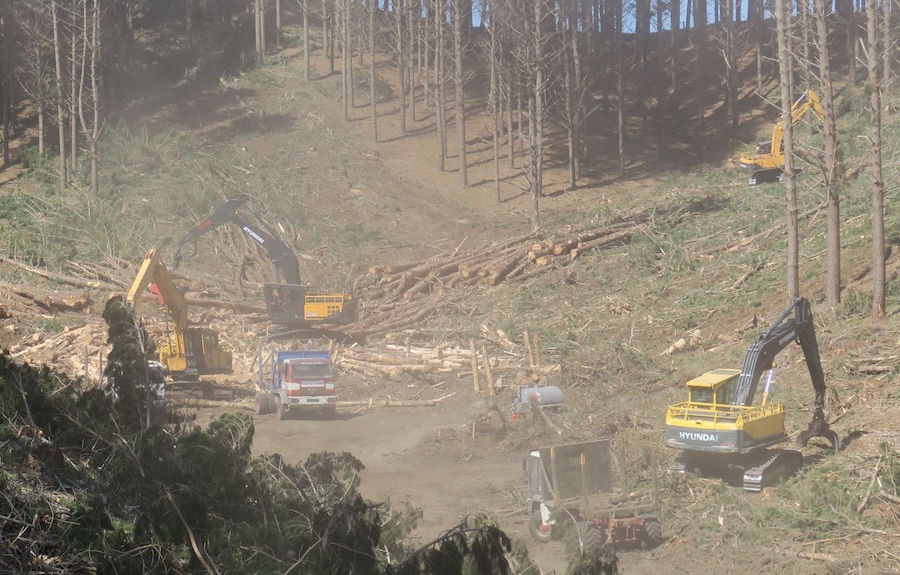
Harvest process - the machinery being used - top right corner (yellow machine) is the feller-buncher cutting down trees; centre left of photo, yellow and black machine is the processor about to cut a debranched tree into logs; in front of it a yellow grappler is about to load up one of the mini logger trucks with logs to deliver to the collection point.
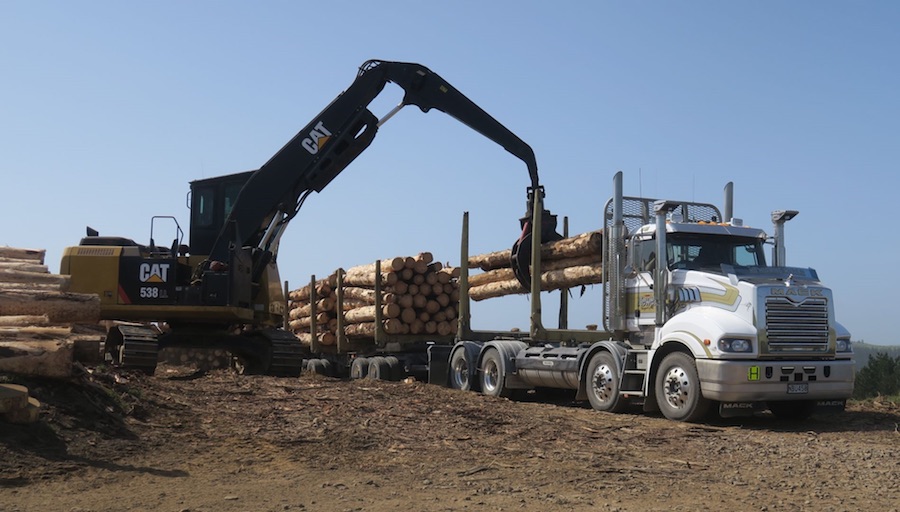
Logging truck - at the collection point/loading area, logs brought in by the mini loggers are loaded onto a normal logging truck to go to the port
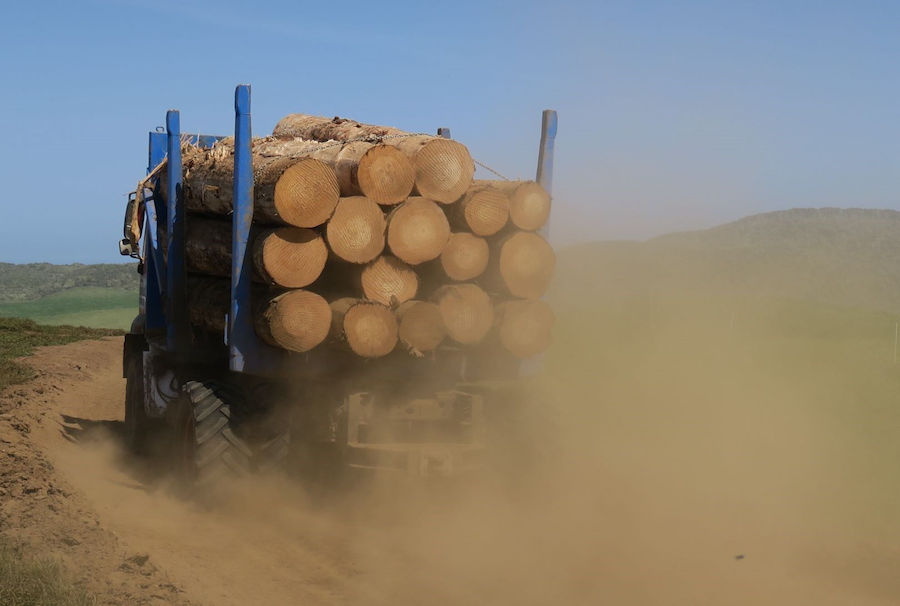
Eight Wood Councils collaborate
Wood Councils in New Zealand are now collaborating under a New Zealand Regional Wood Council Group Accord.
Eight Wood Councils from the forest industry around New Zealand have signed an Accord to improve industry responsiveness and promote shared activity.
- Northland Wood Council
- Eastland Wood Council
- Hawkes Bay Forestry Group
- Southern North Island Wood Council
- Top of the South Wood Council
- Southern Wood Council
- Central North Island Wood Council
- Canterbury – West Coast Wood Council
The intent is to align and expand Wood Council projects and elevate industry performance and success, in identified areas of common interest in the regions.
The Industry Transformation Plan (ITP) calls for improvements to industry function and to grasp the full and unique potential offered by forest products in the necessary shift to a bioeconomy. This is being managed by a Government/sector Steering Group which has established priorities for action and oversees jointly funded projects. Projects underway include:
- Establishment of Timber Unlimited (Timber Design Centre) which investigates standards and promotes the use of timber in buildings.
- Investigate a business case for a potential bio-innovation pilot center in Aotearoa.
|
President: Neil Cullen president@nzffa.org.nz Newsletter editor: Dean Satchell dsatch@gmail.com National Office: Liz Chamberlain admin@nzffa.org.nz Phone: 04 4720432 |
Members |
| Disclaimer: Personal views expressed in this newsletter are those of the writers and do not necessarily represent those of the NZ Farm Forestry Association. | |
 Farm Forestry New Zealand
Farm Forestry New Zealand